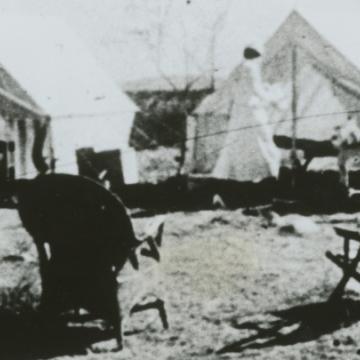History | Story of City of Hope
In 1913, tuberculosis would kill nearly 150,000 people, more than twice the toll taken by cancer. A group of committed volunteers refused to accept this tragedy and established the Jewish Consumptive Relief Association (JCRA), a free, nonsectarian tuberculosis sanatorium.
After hosting several fundraisers, the JCRA placed a down payment on 10 acres of sun-soaked land in Duarte, California, where they would establish the Los Angeles Sanatorium a year later. The original sanatorium consisted of two canvas cottages and ultimately launched a century-long journey that would place City of Hope at the forefront of the nation’s leading medical and research institutions.
Their visionary efforts were rewarded when, by the mid-1940s, the discovery of antibiotics pushed tuberculosis into a decline across the United States. But there was no time for celebration. The pioneering thinkers at City of Hope had already trained their focus on humanity’s next great medical challenge: tackling the catastrophic disease of cancer. Later, they mounted a fight against diabetes and HIV/AIDS. In accepting each new medical challenge, however daunting, City of Hope continually reaffirms its humanitarian vision that “health is a human right.”
In the spirit of that remarkable cause, Samuel H. Golter, one of City of Hope’s early leaders, coined the phrase, “There is no profit in curing the body if, in the process, we destroy the soul.”
Those words became City of Hope’s credo.
Over the decades, research conducted at City of Hope has led to significant advances in modern medicine, including the development of the first synthetic human insulin, the human growth hormone, and the technology behind the widely used cancer-fighting drugs Herceptin, Rituxan, Erbitux and Avastin.
Today, City of Hope stands as a National Cancer Institute-designated comprehensive cancer center — the highest recognition bestowed by the National Cancer Institute—and is a founding member of the National Comprehensive Cancer Network, which offers research and treatment protocols that advance care throughout the nation.
We’ve accomplished a lot and we believe our founders would be proud. But like those original visionaries, as we look toward the next 100 years we know the threats to human health are resilient and relentless and so must be our resolve. City of Hope researchers, physicians, nurses, educators, and staff have all made hope a reality for countless patients and their loved ones and will continue to do so into the next century and beyond.
From our earliest days as simply two tents in the desert, City of Hope has transformed over the decades to become of the nation’s leading-edge cancer treatment and care centers. Explore the timeline of our history and discover some of the breakthrough innovations and achievements that helped build our legacy.
